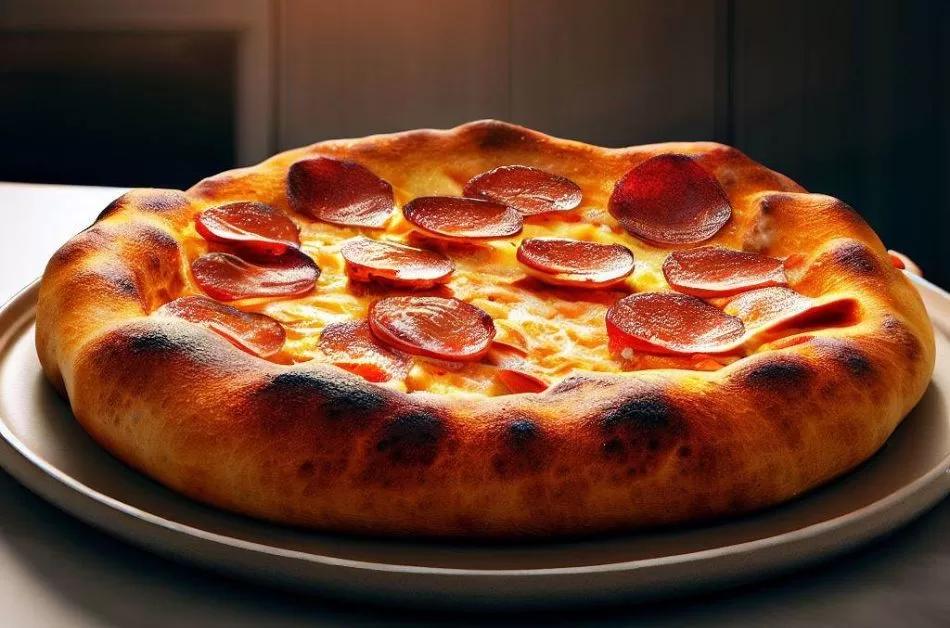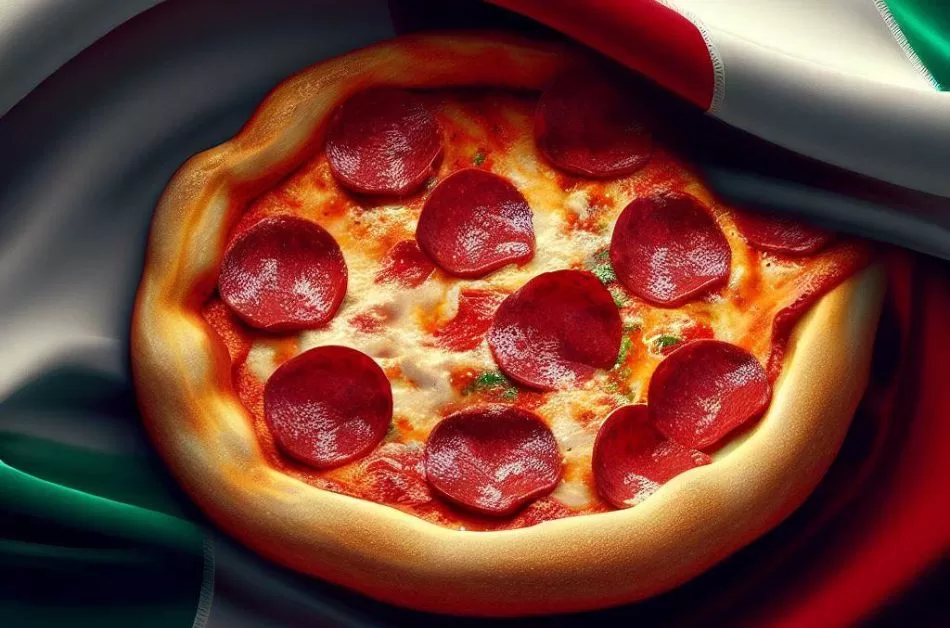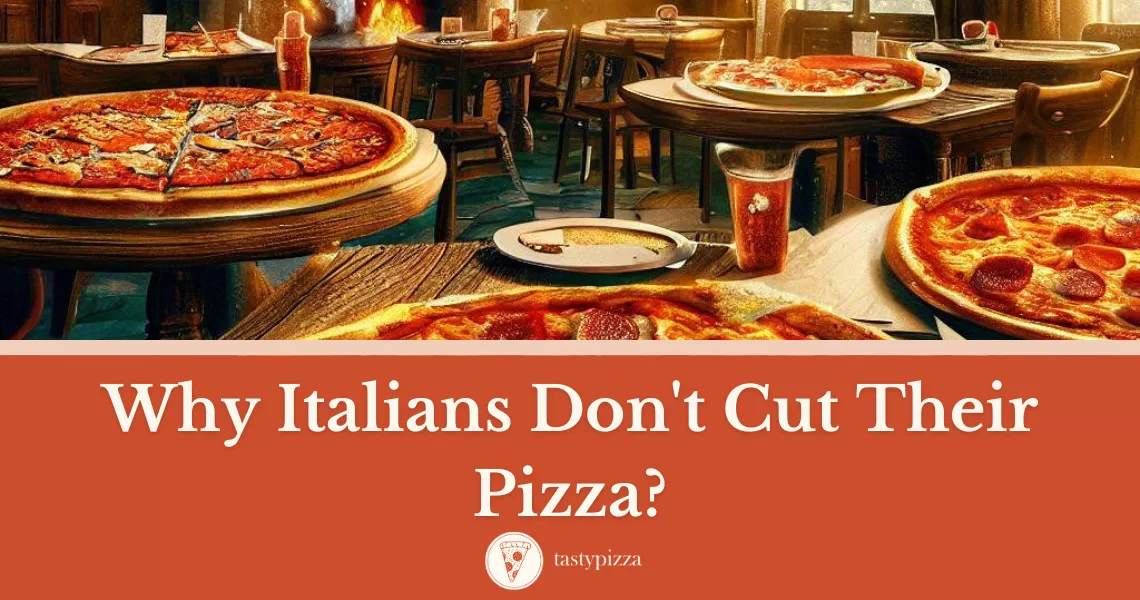Hey there, fellow pizza aficionado!
Have you ever found yourself sitting in a charming pizzeria in the heart of Italy, surrounded by the tantalizing aroma of freshly baked pies, only to notice something intriguingly absent?
No, it’s not the missing pizza cutter from your table – it’s the very act of cutting that has been omitted.
But fear not, because, in this tantalizing journey, we’re diving into the delightful depths of why Italians don’t cut their pizza and why it’s a tradition worth savoring.
Italy – a land of history, art, and passion – also boasts a pizza heritage that dates back centuries.
And just like the majestic ruins of Rome or the intricate paintings of the Renaissance, Italy’s pizza traditions are equally deep-rooted and awe-inspiring.
So, picture this: you’re in a rustic pizzeria with the brick oven roaring, the scent of basil and tomatoes wafting through the air, and the locals indulging in uncut pizzas.
Buckle up, for we’re about to uncover the whys and wherefores, and by the end of this whirlwind tour, you’ll see pizza through the eyes of a true Italian gourmet.
Table of Contents
ToggleThe Etiquette of Eating Pizza in Italy

The History of Neapolitan Pizza
Let’s embark on a historical journey, back to the birthplace of pizza – Naples.
Here, the Neapolitan pizza was born, boasting a proud legacy that’s distinct from its counterparts.
The uniqueness lies in its soft center and airy crust, resulting from a high-hydration dough baked in a scorching wood-fired oven.
This very characteristic dictates the serving style, leading to a tradition that’s surprisingly uncut.
This ain’t your typical pie, and that’s the secret behind its unadulterated, uncut presentation.
Using Utensils: Fork & Knife Drama
Now, you might be thinking, “Wait, isn’t it sacrilege to cut a pizza?”
In the hallowed pizzerias of Italy, it’s not considered rude at all. In fact, it’s the norm.
The Italian culinary culture places a great emphasis on preserving the integrity of flavors, and cutting a pizza can disrupt the balance of the carefully chosen ingredients.
Plus, diving into a whole, uncut pizza has its charm – it’s like embracing the art of dining with open arms, or rather, open hands.
Respect for Ingredients and Toppings
Imagine biting into a slice of pizza – the crispy crust, the gooey cheese, and the flavorful toppings all intertwining in a harmonious dance on your taste buds.
Now, consider this: each ingredient is meticulously chosen for its contribution to the symphony of flavors.
Cutting the pizza risks scattering these elements and altering the original composition.
So, Italians believe in appreciating every bite in its entirety, honoring the labor of love that goes into crafting the perfect pie.
READ ALSO: Our favorite pizza ovens list
How Uncut Pizza Enhances Flavor and Presentation
Science of Taste: Uninterrupted Layers
Let’s get a bit scientific, shall we?
Uncut pizza isn’t just about tradition; it’s about enhancing the taste experience.
Each layer of a pizza – the crispy crust, the melted cheese, the vibrant toppings – plays a crucial role.
Cutting the pizza can release steam, altering the temperature and texture balance.
By leaving the pizza uncut, you’re ensuring that each layer gets its chance to shine, resulting in a harmonious explosion of flavors with every bite.
A Feast for the Eyes
Picture this: an uncut pizza arrives at your table, adorned with the colorful mosaic of ingredients glistening under the warm, inviting glow of the pizzeria lights.
Presentation matters.
In Italy, dining is a multisensory experience, and an uncut pizza is a canvas that showcases the artistry of the pizzaiolo.
It’s a celebration of authenticity and a testament to the fact that how a dish is presented can be just as important as how it tastes.
DON’T MISS: Our recent review of the WISCO Electric Pizza Oven
Delving into Regional Pizza Styles
Beyond Naples: Italy’s Pizza Landscape
Italy isn’t just about Naples when it comes to pizza.
Different regions bring their own unique twists to this beloved dish.
From the rectangular, focaccia-like pizza in Sicily to the crunchier Roman-style pizza, each region has its distinct style that influences how they’re served.
The serving style of a pizza is a window into its soul – it tells a story of its origin, the local ingredients, and the culinary history of the region.
To Cut or Not to Cut: Regional Differences
Now, it’s time to address the elephant in the pizzeria – do Italians ever cut their pizzas?
Well, yes, but there are exceptions.
Pizzas like the Pinsa Romana, a Roman creation made from a blend of whole wheat, millet, soy, rice, and oat flours, are served sliced.
Similarly, certain toppings-heavy pies are sliced for practicality.
However, the essence remains the same – a deep-rooted respect for the pizza’s foundation and a commitment to preserving its flavors.
What The World Can Learn From Italian Pizza Etiquette

Embracing Authenticity in Our Dining Experience
Now that we’ve immersed ourselves in the Italian pizza culture, it’s time to bring a slice of that wisdom to our own dining tables.
Slow down, savor every bite, and take a moment to appreciate the symphony of flavors.
In a world of rush and convenience, adopting a more mindful approach to eating can truly transform our dining experience.
A Nod to Sustainability: Less is More
As we devour the lessons from Italy’s pizza culture, let’s also take a moment to celebrate the sustainability angle.
By forgoing the need for disposable cutlery and pizza boxes, Italians embrace the “less is more” philosophy.
Each uncut pizza is a small step towards a greener, more eco-friendly world, where indulgence doesn’t come at the cost of the environment.
Why Italians Don’t Cut Their Pizza – Final Thoughts
And there you have it – a journey through Italy’s pizza culture that’s left us with a taste of tradition, a dash of flavor wisdom, and a side of regional diversity.
Italy teaches us that it’s not just about eating; it’s about cherishing, savoring, and celebrating every bite.
So, as you embark on your next pizza adventure, whether it’s in a cozy pizzeria or your own kitchen, think twice before reaching for that pizza cutter.
Rediscover pizza, the Italian way, and remember – it’s not just food; it’s an experience.
Italy’s uncut pizza tradition isn’t just a quirky habit; it’s a testament to a culinary heritage that values flavors, presentation, and authenticity.
Ready to embark on your own pizza journey?
Seek out a local pizzeria that serves their pizzas uncut, or channel your inner pizzaiolo by trying your hand at making an uncut pizza at home.
Don’t forget to create an authentic experience by investing in a commercial-grade pizza oven and savoring each moment, just like the Italians do.
Sources:
Frequently Asked Questions
It’s all about adaptation. Pizzerias outside Italy often cater to local customs and the on-the-go culture. Sliced pizzas offer convenience for diners in a hurry.
Not at all! Italy’s pizza etiquette is rich in regional variations. If you have a preference, it’s perfectly acceptable to request an uncut or sliced pizza.
Italians take their takeaway pizzas seriously. The tradition involves folding the pizza into a “libretto” – a wallet-like shape that’s easy to hold and eat on the go.
Mastering the fork and knife technique is the key. Hold the crust with your hands and use the utensils to cut through the center, maintaining the balance of flavors and textures.
Indeed! Some Italian pizzas are meant to be enjoyed with your hands. Pizzas like the Pinsa Romana have a sturdier base and can be eaten like a traditional slice, combining the best of both worlds.

Ethan Davis, a culinary arts graduate with a deep passion for pizza, is an esteemed author in the field. With a wealth of professional experience in diverse pizza restaurants, Ethan has honed his skills and expertise in the art of pizza making. His mission is to share his extensive knowledge with a wider audience, captivating them through engaging articles that showcase his profound understanding and unwavering enthusiasm for the subject. Through his writing, Ethan aims to inspire pizza enthusiasts worldwide, fostering a greater appreciation for the craft and encouraging others to explore the delicious world of pizza.

